- 6. Cavendishia LINDLEY, nom. conserv. Bot. Reg. 21: pl. 1791 (1835).
- -- Type: Cavendishia nobilis LINDLEY.
- ?Chupalon ADANSON, Fam. Pl. 2: 164 (1763). -- Type: none cited.
- Socratesia KLOTZSCH, Linnaea 24: 22 (1851). -- Type: Socratesia melastomoides KLOTZSCH.
- Polyboea KLOTZSCH, Linnaea 24: 30 (1851) non KLOTZSCH ex ENDLICHER (1850
- =Euphorbiaceae). -- Lectotype: Polyboea laurifolia KLOTZSCH.
- Proclesia KLOTZSCH, Linnaea 24: 32 (1851). -- Lectotype: Proclesia cordata KLOTZSCH.
Reference: LUTEYN, J. L. Ericaceae--Part I. Cavendishia
. Fl. Neotrop. Monogr. 35: 1--290 (1983).




Erect shrubs, evergreen, epiphytic or terrestrial. Leaves alternate, coriaceous,
marginally entire and revolute, both surfaces usually with multicellular, reddish
or blackish, slightly sunken, glandular trichomes to 0.2 mm long, if glabrescent
appearing punctate; pinnate or plinerved. Inflorescence axillary, usually solitary, racemose
or subfasciculate, surrounded at the base by a series of bracts, the smallest minute
and triangular, the largest conforming to the shape and size of the individual floral bracts; inflorescence bracts few to numerous, imbricate, coriaceous, smooth or minutely
striate or muricate, marginally scarious and usually minutely glandular fimbriate;
floral bract caducous or usually persistent, usually large and showy; bracteoles
basal or rarely midway up the pedicel, usually glandular. Flowers 5-merous, without
odor; aestivation valvate; calyx articulate with pedicel; hypanthium basally expanded
into a apophysis or not; limb erect or spreading; lobes erect or connivent after anthesis, usually glandular; corolla tubular, usually carnose when fresh, the lobes
usually flaring at anthesis; stamen 10, subequal or rarely unequal, subequalling
the corolla; filaments usually distinct, rarely slightly coherent at the extreme
base at anthesis, alternately unequal, lacking spurs; anthers alternately unequal, lacking
disintegration tissue; thecae smooth or slightly granular; tubules about the same
width as the thecae and about twice as long, dehiscing by elongate clefts; pollen
without viscin threads; ovary inferior, 5-locular, surmounted by a flat or cupuliform
nectariferous disc; style straight or sigmoid, usually glabrous; stigma minutely
5-lobed, truncate but slightly flaring at anthesis. Fruit a berry, dark blue-black.
Cavendishia
is a neotropical genus of epiphytic and terrestrial shrubs. It is the largest neotropical
ericaceous genus with approximately 155 species, distributed from Mexico (Oaxaca)
south through montane Central America to Bolivia, and as far east as Brazil (Amapá).
Key to the Species of Cavendishia
- 1a.
- Leaves deeply cordate, amplexicaul
- .........................................................................................C. complectens var. striata
- 1b.
- Leaves not deeply cordate, not amplexicaul.
- 2a.
- Inflorescence a panicle
- ................................................................................C. lebronae
- 2b.
- Inflorescence a raceme.
- 3a.
- Stamen 1/2--1/3 corolla length; rachis fusiform to clavate with greatest diameter
at middle or distally, the floriferous nodes restricted to distal portion; corollas
membranous and white proximally becoming leathery and green distally.
- 4a.
- Floral bracts (not lower sterile inflorescence bracts) coriaceous, the venation
striate-parallel; bracteoles none.
- ...........................................................C. mariae
- 4b.
- Floral bracts membranous, the venation reticulate; bracteoles 2.
- 5a.
- Rachis 4--6 (-10) cm long and 7--12 mm diam. distally; calyx limb infundibuliform,
(7-) 10--15 (-17) mm long; pedicel 0--1.3 mm long
- ...................................................C. micayensis
- 5b.
- Rachis 1--2 cm long and 2.5 mm diam. distally; calyx limb cylindric-campanulate,
4--7.5 mm long; pedicel 4--7 (-10) mm long
- ...................................................C. venosa
- 3b.
- Stamen equal to corolla length; rachis cylindric with greatest diameter at base,
the nodes floriferous over entire length or only lowest few sterile; corollas completely
membranous, variously colored.
- 6a.
- Corollas greater than 12 mm long; floral bracts persistent (at least through
anthesis), greater than 12 mm long, variously colored but never green.
- 7a.
- Calyx lobes broadly imbricate over entire length at anthesis.
- 8a.
- Plants densely pilose on stem, leaves, and calyces; leaves bullate; bracteoles
10--12 (-16) mm long; calyx lobes 9--12 mm long
- .......................................C. orthosepala
- 8b.
- Plants glabrous; leaves flat not bullate; bracteoles 4--6 mm long; calyx lobes
4--7 mm long
- .......................................C. zamorensis
- 7b.
- Calyx lobes separate at anthesis (slightly imbricate near base in C. pubescens
).
- 9a.
- Calyx densely woolly, the matted hairs persistent; leaves persistently soft-pilose
beneath
- .......................................C. pubescens
- 9b.
- Calyx glabrous to pilose, but never woolly and the hairs never matted; leaves
glabrous to glabrate.
- 10a.
- Calyx lobe margins scarious or glandular-fimbriate, the fimbriae distinct or
becoming laterally fused and then sometimes forming a thin, supramarginal gland to
1.2 mm long.
- 11a.
- Calyx (9-) 11--15 mm long, the limb erect after anthesis and the lobes spreading
- ...................C. cuatrecasasii
- 11b.
- Calyx (3.5-) 4--11 mm long, the limb and lobes connivent or connivent/twisting
after anthesis.
- 12a.
- Calyx hypanthium basally rounded or truncate, never apophysate or lobed; calyx
lobes connivent after anthesis; corolla (12-) 15--20 (-25) mm long
- ...........C. bracteata
- 12b.
- Calyx hypanthium basally apophysate; calyx lobes (sub)connivent/twisting after
anthesis; corolla 16--40 mm long.
- 13a.
- Calyx hypanthium deeply lobed at base, equal to or slightly longer than calyx
limb at anthesis; pedicel (2-) 3.5--8 mm long; calyx lobes 2.5--4.5 mm long
- ...C. nobilis var. capitata
- 13b.
- Calyx hypanthium not lobed at base, but instead with a rim 0.5--2 mm long which
is produced below the articulation, the hypanthium shorter than calyx limb at anthesis;
pedicel 8--20 mm long; calyx lobes 1.3--2.5 mm long
- ....C. tarapotana
- 14a.
- Rachis (1-) 3--8 (-13.5) cm long, bearing (8-) 15--25 flowers; floral bracts
14--28 mm long; corolla 16--25 mm long; 400--1960 m (mostly < 1300 m), along the
eastern foothills of the Andes
- ....................12a. var. tarapotana
- 14b.
- Rachis 0.5--2.5 (-2.8) cm long, bearing 5--6 (-8) flowers; floral bracts 35--53
mm long; corolla 33--40 mm long; 1100--1900 m, in the western foothills of the
Andes
- ....................12b. var. gilgiana
- 10b.
- Calyx lobe margins glandular-callose over entire length, or entire calyx lobe
glandular-callose.
- 15a.
- Calyx lobes with callose glands along margins only.
- 16a.
- Leaves 26--45 x 7--20 cm
- .........C. grandifolia
- 16b.
- Leaves (6.5-) 8--14 (-17.5) x 2--5 (-7) cm
- ..........C. engleriana
- 17a.
- Leaves basally rounded to obtuse, glabrous, 5 (-7)-plinerved; petiole (4-) 8--13
(-16) mm long; floral bract 35--50 mm long, marginally eglandular; pedicel 7--12
(-15) mm long; bracteoles to 14 mm long; calyx lobes (2-) 2.5--3.8 mm long
- ...14a. var. engleriana
- 17b.
- Leaves basally cuneate, moderately hispid on both surfaces, 3-plinerved; petiole
6--8 mm long; floral bract 30--36 mm long, marginally densely glandular; pedicel
5--8 mm long; bracteoles 4--7 mm long; calyx lobes 1.5--2.5 mm long
- ...14b. var. ecuadorensis
- 15b.
- Calyx lobes completely glandular-callose and this sometimes extending onto limb
proper.
- 18a.
- Corolla lobes glandular-callose; leaves plinerved; Zamora-Chinchipe (Cordillera
del Cóndor)
- ....C. sirensis
- 18b.
- Corolla lobes not glandular-callose; leaves pinnately nerved or plinerved; Esmeraldas
and Carchi provinces.
- 19a.
- Leaves pinnately nerved, (4-) 5--15 cm long; pedicel provided at distal tip
with angular or oblong, greeenish glands which secrete a white, sticky latex; corolla
becoming swollen distally, then abruptly constricted into throat and lobes
- ...C. violacea
- 19b.
- Leaves plinerved, (4.5-) 7--23 (-35) cm long; pedicel without glands; corolla
cylindric throughout and only slightly narrowed at throat
- ...C. callista
- 6b.
- Corollas less than 12 mm long; floral bracts caducous (prior to anthesis), less
than 8 mm long, and green in color.
- 20a.
- Inflorescence to 7-flowered; calyx lobe margins glandular-fimbriate
- ........................................................C. parviflora
- 20b.
- Inflorescence (7-) 16--40-flowered; calyx lobe margins glandular-callose or
with few stout glandular fimbriae.
- 21a.
- Leaves (5.5-) 11--16 (-23.5) x (2-) 4.5--5.5 (-10) cm; bracteoles marginally
glandular-callose
- ...............................................C. awa
- 21b.
- Leaves (2.5-) 5--10 (-15) x 1--4.5 (-5.5) cm; bracteoles marginally glandular-fimbriate.
- 22a.
- Leaf base short- or long-attenuate to cuneate, often slightly involute causing
petiole to appear winged; reticulate veinlets of leaves prominent beneath; rachis
glabrous; pedicel 10--18 mm long; calyx lobes apiculate; Esmeraldas Prov., 250--500 m altitude
- .......................................C. palustris
- 22b.
- Leaf base obtuse or rounded to subcordate, never involute, the petiole subterete;
reticulate veinlets obscure on leaves beneath; rachis glabrous or short-pilose;
pedicel 5--13 mm long; calyx lobes conspicuous; E Ecuador (Oriente), 900--2225 m altitude
- ......................................C. isernii
- 23a.
- Calyx lobes marginally glandular-callose, separate (not imbricate); hypanthium
basally apophysate with a smooth rim
- ............................21a. var. isernii
- 23b.
- Calyx lobes marginally glandular-fimbriate, often imbricate; hypanthium basally
rounded or truncate
- ...........................21b. var. pseudospicata



